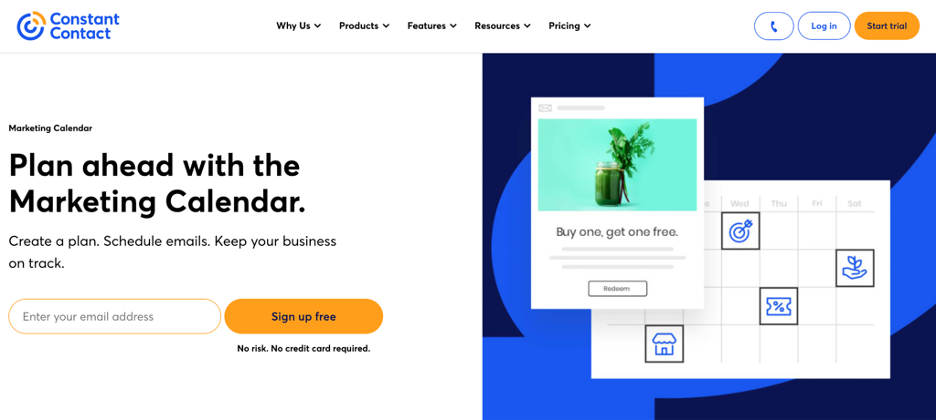How to Create an Email Marketing Calendar Step-by-Step Guide
In the fast-paced world of digital marketing, knowing how to create an email marketing calendar is crucial for any business. An email marketing calendar serves as a roadmap for your campaigns, ensuring that you stay organized, timely, and relevant in your communications with customers. It helps align your marketing goals with your broader business objectives while enhancing audience engagement through well-planned content.
Understanding the Importance of an Email Marketing Calendar

Creating an email marketing calendar isn’t just about scheduling emails. It’s about strategically planning your communications to maximize their impact. In this section, we will delve into the benefits of adopting a structured approach to email marketing and how it aligns with your overall business goals.
Benefits of a Structured Approach

A structured email marketing calendar provides clarity and consistency. By laying out your campaigns ahead of time, you can identify periods of high potential engagement, such as holidays or special events.
This advance planning allows for better resource allocation. You can avoid last-minute scrambles to meet deadlines, ensuring that your email content is polished and well-crafted. Moreover, with a clear schedule in hand, it’s easier to delegate tasks among team members and hold everyone accountable for their contributions.
Additionally, a structured approach fosters creativity. Knowing when emails are scheduled encourages brainstorming sessions to develop unique content ideas. It also allows you to anticipate market shifts or trends that may require quick adjustments to your plans. This adaptability is key in today’s rapidly changing digital landscape.
Aligning Campaigns with Business Goals
Aligning your email campaigns with business objectives is essential for maximizing ROI. Your calendar should reflect the overarching goals of your organization, whether that’s increasing sales, driving traffic to your website, or fostering brand loyalty.
For instance, if your business aims to launch a new product line, your email calendar should include promotional strategies leading up to and following the launch date. Coordinating your campaigns with other marketing efforts like social media, content marketing, and PR ensures a cohesive message across all platforms, elevating the effectiveness of each initiative.
Moreover, having a clear understanding of your business goals allows you to create targeted campaigns that resonate with your audience. When your audience sees that your emails align with their interests and needs, they are more likely to engage, ultimately driving higher conversion rates.
Enhancing Audience Engagement

Audience engagement is not just about clicking ‘open’ on an email; it’s about creating a meaningful dialogue with your subscribers. An email marketing calendar enables you to plan content that speaks directly to your audience’s interests throughout the year.
When you use data analytics to inform your calendar, you can tailor your content to specific segments within your email list. For example, if you notice a segment of your audience responds best to educational content, you can allocate time slots in your calendar specifically for those types of emails.
Furthermore, a well-timed email can significantly enhance user engagement. Imagine sending an email just before a long weekend, offering special promotions or tips related to that holiday. Such timing can create excitement and anticipation, prompting higher open and click-through rates.
Defining Your Email Marketing Objectives

To successfully implement an email marketing calendar, you first need to define your objectives. This involves setting clear goals and identifying how you’ll measure success through key performance indicators (KPIs). A thorough understanding of your target audience‘s needs is also imperative.
Setting Clear Goals for Your Campaigns
Before diving into the nitty-gritty of your email campaigns, establish clear, measurable goals. These could range from increasing newsletter sign-ups to boosting revenue from email sales by a certain percentage. The more specific you can be, the better.
Goals should adhere to the SMART criteria, specific, measurable, achievable, relevant, and time-bound. For example, instead of saying, “I want to increase sales,” aim for “I want to boost sales from our email campaigns by 20% over the next quarter.” This specificity makes it easier to track progress and adjust tactics as necessary.
Once you’ve defined your goals, categorize them based on campaign type. For instance, promotional campaigns have different objectives compared to nurturing campaigns. Having these distinctions will help you fine-tune your messaging and calls-to-action.
Identifying Key Performance Indicators (KPIs)
KPIs are crucial for measuring the success of your email marketing efforts. Common KPIs include open rates, click-through rates, conversion rates, and unsubscribe rates. Each KPI offers insights into varying aspects of your email performance.
Open rates gauge the effectiveness of your subject lines and overall email deliverability. Meanwhile, click-through rates delve deeper, providing data on whether recipients find your content engaging enough to take action.
Conversion rates illustrate how well your emails drive purchasing decisions, showcasing the ultimate goal of most promotional campaigns. Unsubscribe rates can signal issues with content relevance or frequency, highlighting areas needing improvement.
By regularly reviewing these metrics, you’ll gain valuable insights that can guide future campaigns. It’s a cycle of learning, the more you analyze, the more refined your strategy will become.
Understanding Target Audience Needs and Preferences
Knowing your target audience inside and out is fundamental to crafting effective email campaigns. Take the time to research what your subscribers truly want. Utilize surveys, polls, and social media interactions to gather insights about their preferences.
Segmenting your email lists based on this data can lead to highly personalized campaigns. For example, if a portion of your audience shows interest in eco-friendly products, consider dedicating specific emails to highlight sustainable options in your catalog.
Additionally, pay attention to engagement metrics. If certain topics consistently generate high open and click-through rates, consider adjusting your content calendar to focus more on similar themes. Tailoring your approach according to audience feedback fosters loyalty and keeps your subscribers engaged.
Planning Content Themes and Topics

With your objectives set, it’s time to brainstorm content ideas that will resonate with your audience. This process involves thinking creatively about seasonal themes, integrating product launches, and considering upcoming promotions.
Brainstorming Relevant Content Ideas
Creative brainstorming is at the heart of successful email marketing. Start by placing yourself in the shoes of your audience. What challenges do they face? What questions do they often have? Use customer feedback and insights to inspire your content calendar.
Consider conducting team brainstorming sessions where everyone contributes ideas. Encourage a free-flowing environment where no idea is too small or insignificant. After generating a robust list of potential topics, categorize them based on themes, seasons, or specific campaigns.
Don’t forget to explore content formats beyond traditional newsletters. Think about including webinars, video content, or interactive elements like polls and quizzes. These innovative formats can significantly enhance audience engagement and keep your subscribers looking forward to your emails.
Seasonal and Holiday Considerations
Seasonal events and holidays present excellent opportunities for tailored email campaigns. Whether it’s Valentine’s Day, Christmas, or Back-to-School season, align your themes and messages with these occasions.
Consider creating limited-time offers that are exclusive to these events. For example, sending a festive discount promo during the holiday season can entice customers to make purchases. Similarly, themed content, like gift guides or seasonal tips, adds additional value to your emails.
Planning around these dates should start well in advance. Keep a close eye on your calendar so you’re prepared for upcoming occasions. This foresight ensures your emails hit inboxes at just the right moment.
Integrating Product Launches and Promotions
If your business regularly launches new products or services, incorporate these events into your email marketing calendar. Pre-launch teasers can build anticipation, while post-launch follow-ups can encourage conversions.
Utilize countdown timers in your emails to create urgency and excitement. Highlight unique selling propositions and provide incentives like exclusive discounts for subscribers.
Additionally, cross-promote these launches across other marketing channels for maximum impact. Ensure consistency in messaging across your website, social media, and email campaigns. This omnichannel approach reinforces the importance of your product launch and enhances consumer awareness.
Designing Your Email Marketing Calendar

Now that you’ve planned your content, it’s time to design the calendar itself. Choosing the right tools and structuring your layout effectively will help you stay organized and efficient.
Choosing the Right Tools and Software
There are numerous tools available to assist with creating and managing your email marketing calendar. Popular options include Google Calendar, Trello, Asana, and specialized marketing software like Mailchimp or HubSpot.
Select a tool that best suits your team’s workflow. If your team prefers visual organization, Trello’s card system might be ideal. On the other hand, if you need comprehensive analytics and email design capabilities, marketing platforms like Mailchimp are worth considering.
Regardless of the tool you choose, ensure that it allows for collaboration. Multiple team members should have easy access to update timelines, add notes, and assign tasks. This transparency promotes accountability and ensures everyone is aligned.
GoHighLevel makes creating an email marketing calendar easy with its all-in-one marketing platform. By utilizing its automation and scheduling tools, users can plan, schedule, and track email campaigns in advance. The platform’s CRM integration ensures that your content reaches the right audience at the right time, while its analytics feature allows for performance tracking and adjustments. GoHighLevel streamlines the process of organizing and executing email campaigns, helping businesses stay consistent and achieve their marketing goals efficiently.
Structuring Your Calendar Layout
Your calendar should be visually intuitive and straightforward. Clearly outline each campaign, including dates, content themes, and any responsibilities assigned to team members.
Consider color-coding different types of campaigns, for instance, promotional emails could be green, while educational content can be blue. This differentiation makes it easier to view your overall strategy at a glance.
Incorporate space for notes or updates. Encouraging team members to leave feedback or comments can promote continuous improvement and innovation in your campaigns.
Including Important Dates and Milestones
In addition to content planning, your calendar should feature important dates and milestones relevant to your business. Consider marking key dates such as product launch days, major sales events, or industry conferences.
Also, include deadlines for drafts, internal reviews, and final approvals. Keeping everyone aware of these timelines helps prevent last-minute rushes and guarantees that all campaigns are polished before hitting inboxes.
Assigning ownership of specific tasks ensures accountability. Each team member should know what’s required of them and by when. This segmentation aids in smoother collaboration and enhances the quality of your output.
Implementing and Managing the Calendar

With your email marketing calendar designed, the next step is implementation and management. Assigning responsibilities, establishing a review process, and adapting to feedback are critical components of this phase.
Assigning Responsibilities to Team Members
Each team member should have clearly defined roles within the calendar. This might include who is responsible for drafting content, designing graphics, or analyzing performance metrics post-campaign.
Regular check-ins can help maintain accountability. Set up recurring meetings to discuss progress and roadblocks. This open communication fosters cooperation and a stronger team dynamic.
Using collaborative software can also streamline this process. Team members can leave comments, tag others for input, and share files, ensuring that everyone remains informed and engaged.
Establishing a Review Process
A robust review process is vital for maintaining the quality of your email campaigns. Before any email goes live, it should undergo a thorough review by multiple team members.
Develop a checklist of criteria to evaluate each campaign. This may include reviewing subject lines, testing links, checking formatting across devices, and verifying compliance with privacy regulations.
Encouraging peer reviews can also bring fresh perspectives. A second set of eyes may catch errors or suggest improvements that can elevate the overall quality of your emails.
Adapting to Changes and Feedback
In the dynamic realm of digital marketing, adaptation is key. Regularly review your campaign performance and solicit feedback from both your team and your audience.
Analyze which types of content perform best and adjust your calendar accordingly. Don’t hesitate to pivot if something isn’t working, embrace flexibility.
Similarly, be open to suggestions from team members about improving processes or exploring new ideas. Cultivating a culture of continuous improvement can unleash your team’s creative potential and contribute to ongoing success.
Measuring Success and Making Adjustments

The final step in the calendar creation process is measuring the success of your campaigns. Analyzing performance data, iterating strategies for improved results, and keeping your calendar updated for future campaigns are essential for growth.
Analyzing Campaign Performance Data
Diving into your campaign performance data will reveal invaluable insights. Pay close attention to KPIs identified earlier and draw conclusions about what’s working and what’s not.
A/B testing subject lines, send times, and content variations can yield significant insights. Track how these changes influence engagement metrics and adapt your calendar based on what resonates with your audience.
On top of that, conduct regular reviews of your overall email marketing strategy. Are there seasonal patterns in engagement? Are some email types outperforming others? Use these findings to refine your future campaigns.
Iterating on Strategies for Better Results
The beauty of email marketing lies in its ability to evolve. Based on performance data, feel empowered to iterate on your strategies.
If you discover that educational content drives higher engagement than promotional emails, consider revising your content calendar to prioritize informative themes.
Approach every campaign as a learning opportunity. Iterate, experiment, and embrace the trial-and-error process. Remember, the goal is to optimize your efforts continuously, ensuring that your content remains relevant and engaging.
Keeping the Calendar Updated for Future Campaigns
An email marketing calendar is a living document. As your campaigns progress, continue updating it with new insights, feedback, and ideas.
Regularly assess what worked well and replicate those successes in future campaigns. Conversely, learn from missteps to avoid repeating them.
Integrate continual feedback loops. Both your team members and audience should feel encouraged to provide input on campaign effectiveness. This two-way communication builds goodwill and strengthens relationships.
Summary
Mastering how to create an email marketing calendar is an invaluable skill for marketers aiming to improve their outreach efforts. A well-organized calendar not only streamlines your campaigns but also enhances alignment with broader business goals.
By defining clear objectives, planning relevant content, utilizing the right tools, and effectively measuring success, you can continually refine your email marketing strategy.
Remember that the journey doesn’t end once the calendar is created. It’s a dynamic process that requires ongoing analysis, adaptation, and creativity. With these principles in mind, you’ll be well-equipped to engage your audience meaningfully and achieve lasting success in your email marketing endeavors.




